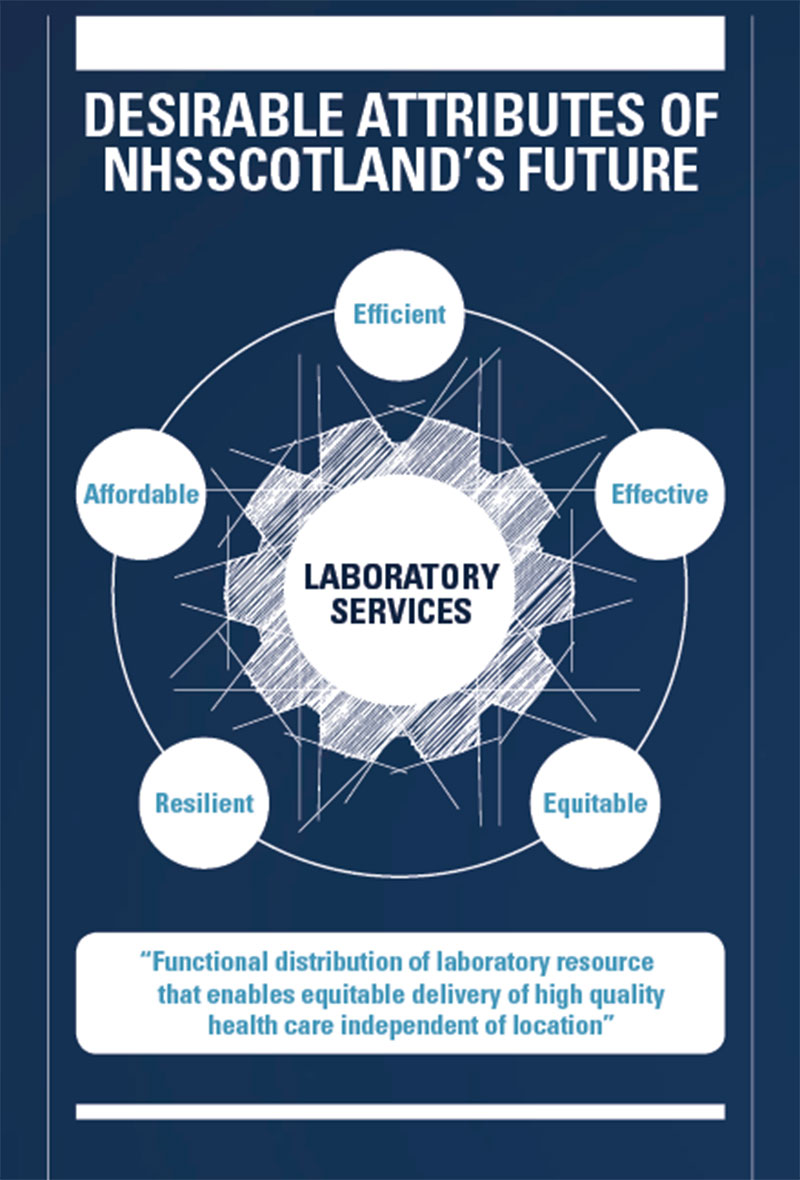Bill Bartlett and Paul Hawkins on transforming NHSScotland’s laboratory medicine services.

NHS Scotland provides healthcare to a population of approximately 5.3 million people across an area that constitutes a third of the UK land mass. It It faces challenges around rising demand and many other drivers for change common to the rest of the UK. These, in combination with a fundamental requirement to deliver better care, better experience of care and better cost of care (triple aim), are driving the need for transformation of services. It follows that underpinning services, such as those provided by laboratories, must also undergo transformation to deliver future requirements of the evolving healthcare system. Given the dependence of patient pathways and outcomes upon laboratory outputs, failure to deliver transformed services that are optimally configured to address both local and national priorities will compromise the value of investment in diagnostics and delivery of the triple aim. New service configurations need to deliver equitability of access, efficiency in delivery, effectiveness in impact, resiliency and sustainability of service and be not least affordable. Taking all these issues into account, a process involving service providers and stakeholders has resulted in the agreement to move forward with the development of a Distributed Service Model (DSM) for laboratory services within NHSScotland. A blueprint and set of guiding principles have been developed to enable the DSM delivery under a new governance structure. This sees the establishment of a Laboratory Oversight Board to facilitate the development of the DSM through new Regional structures. NHS National Services Scotland (NSS) has been tasked by the Scottish Chief Executives group with delivery of a National Laboratories Programme, which has been allocated £6.7m for initial key work to enable the developments.
The current National Laboratories Programme has arisen from work undertaken through the NHSScotland Shared Services Programme (SSP), which was extended to deliver a health portfolio that included laboratories in 2015. In 2016, a small team was established within the SSP Health portfolio tasked to develop the laboratories element. That team worked with the laboratory service providers and other stakeholders through a number of workshops to develop a position paper on laboratory shared services that was presented to NHSScotland chief executives in October 2016. That paper included a detailed PESTEL and SWOT analysis of the current service model and also took into account work undertaken by NHSScotland’s managed diagnostics networks presented to the Diagnostic Steering Group in 2015. It resulted in a mandate to move forward to delivery of a strategic paper based on a proposal to develop a DSM for laboratory services in Scotland and to establish a small number of working groups around information technology, data and innovative technology. The position paper also identified a set of guiding principles to be followed in the development of services to realise the concept of the DSM.
The DSM strategy paper was delivered in July 2017 and with a high-level description of the proposed model emerging through extensive stakeholder engagement. The contention put forward was that stakeholders agreed that there is an opportunity to use the significant resources available to health boards to deliver laboratory services in a way that is more efficient, effective, equitable, resilient and affordable. The DSM concept is one of delivery an optimal service configuration in the various localities across Scotland. The delivery units are to provide the correct volume, range and repertoire of tests reported within an appropriate timescale to meet the needs of the locality and configured as a whole to enable delivery of national priorities in the context of the triple aim. A strategic is delivery of an optimal distribution of laboratory services across Scotland with concentration of workloads and sharing of expertise across wider geographical areas. The concept is one that addresses drivers for change and requires delivery of a functional distribution of service across the system to deliver whole healthcare system value and resilience, rather than de facto centralisation in to reduce costs.

Delivery will depend upon coordination across and between laboratories and standardisation of operating procedures across services. In planning terms, this will equate to a single virtual service functioning to consistent standards across the wider organisations while different aspects of service are delivered by the relevant operational unit at the most appropriate level whether national, regional, health board level, individual hospital or community.
The strategy paper was approved and work subsequently undertaken to develop a full business case presented to CEs in April of 2018. This built on previous work with further input from an IT Group, a Data Group and DSM Design Group. The case reflected the requirement identified to take an incremental approach to the delivery of the DSM, the emerging regionalisation agenda arising from the publication of the Scottish Government’s Health and Social Care Delivery Plan in 2016 and the need to have a new governance structure to support this agenda and ensure national consistency of service. The case was accepted and funding allocated to a National Laboratories Programme with the following Key deliverables:
- A new governance structure that supports the delivery of a DSM with national consistency
- A National Laboratories Blueprint. Delivering a vision for the laboratory services focusing on process, organisation, technology and information.
- IT Connectivity, with all Scottish laboratories implementing NPex for lab to lab electronic ordering
- Data sharing, through development of a national data platform to support business and clinical intelligence requirements
- A high level specification for LIMS to enable national consistency in a key procurement area
It is important to note that the incremental approach is being taken with the view of achieving short- to medium-term benefits, adding value to laboratory services, while maintaining a clear focus on the longer-term transformational change required to deliver the optimal DSM. The final form of the DSM will ultimately reflect function, meeting the needs of stakeholders, which in turn will be defined by the requirements of NHSScotland’s healthcare delivery model evolving in the context of the National Clinical Strategy.
Longer term benefits are anticipated that are both financial and non-financial, in part these will be achieved through the appropriate consolidation of services, facilities and equipment and whole system laboratory service redesign. The business case illustrated the potential benefits of laboratory service transformation with examples from current initiatives in Scotland. It also recognised the fact that delivery of optimised services with appropriate allocation of resources has the potential to deliver significant downstream benefits to overall healthcare delivery and the potential to address current risks (e.g. service resilience, requirement for investment in new technologies). Clearly there is a drive for change to address the issues of variation and waste within the current system, but this should be seen as an opportunity to identify resource to invest in developments that increase the effectiveness and value of the allocated resource envelope. Developments in technology, information and knowledge management, artificial intelligence, the medical evidence base and the emergence of new modes of practice will challenge the delivery model and potentially enhance the value of redesigned services.
The scale and complexity of the task to be undertaken to deliver the DSM should not be underestimated. NHSScotland’s clinical laboratory services are currently provided by 14 territorial and two special health boards (Scottish National Blood Transfusion Service, Golden Jubilee National Hospital) and have a projected spend of £1.5b pounds over the next five years. Focusing on the territorial boards, it is estimated that over 3,800 full-time equivalent staff are directly involved in service delivery across 27 sites out of 87 laboratories. In addition, total NHS service provision also includes a number of national services commissioned by NSS; there is therefore a considerable resource managed and applied thorough a complex model with multiple stakeholders involved in service provision and usage. Following the publication of the Health and Social Care Delivery Plan, the territorial Boards have been allocated to three regions for the purposes of planning:

The National Laboratories Blueprint (NLB) attempts to capture the here and now of the current laboratory services model, identifies the steps that need to be taken to deliver the desired future model for laboratory services and identifies the desired endpoints to be delivered by the DSM. It supports an incremental approach to transformation that, if adopted, will enable delivery of the national strategy for laboratories and progression towards a DSM that will meet NHSScotland’s needs today and in the future.
The current focus on laboratories in Scotland presents both a challenges and opportunity for those providing services. The approach has delivered a clear vision for the future of services that necessitates service transformation. This clearly delivers challenge the old order of things. The drivers for change impacting on the current service model are increasing in number and severity and drive the need for the transformation. Not all are adverse. The availability of new technologies and new approaches to service delivery that support new ways of working provide new opportunities for all working in laboratories. In addition, the approach being taken to transformation in Scotland recognises the value of diagnostics in healthcare and has at its core a focus on value and not cost with a key focus being the triple aim. This is being increasingly recognised and is a positive for those proposing service developments. The combination of the DSM blueprint, the guiding principles, the new governance structures, increased understanding of the value of diagnostics in healthcare and the adoption of an incremental approach to change towards an optimal delivery model provides massive opportunities for the future of laboratory diagnostics in Scotland.
Dr Bill Bartlett is Clinical Lead National Laboratories Programme NHS National Services Scotland. Paul Hawkins is Chief Executive NHSFife and Chair of the Laboratories Oversight Board.
Image Credit | iStock
